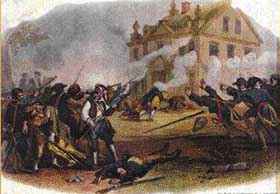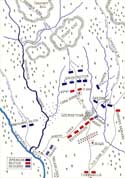Colonial Wars |
American Wars |
Link To This Page — Contact Us —
The Battle of Germantown
October 4, 1777 at Germantown, Pennsylvania
 |
|||||||||||||||||||||
|
Lt. Gen. William Howe was camped outside of Philadelphia and Gen. George Washington's American forces were looking to drive Howe away from Philadelphia and re-capture it. Washington basically devised a plan to divided his army into 4 groups with each group taking a different path and to have a night march. Hopefully in the early morning his troops would hit Howe's army from 4 different roads all at the same time. This was a brilliant plan if it could be carried out successfully. It would surprise the British on both flanks and in the center and hopefully it would compel the British to retreat from the vicinity Philadelphia and leave it open for the rebel re-capture.
The British were camped from along School House Lane and Church Street. The British units from left to right were a division of Hessians under Lt. Gen. Baron William Fnyphause, 2 British support brigades, a division of British regulars under James Grant, a division of the Queens Rangers (Tory units raised in the colonies) and 2 battalions of British Guards. Located near the Chew House was the 14th regiment under Lt. Col. Thomas Musgrave. His job was to support the 2nd Light Infantry Battalion under Capt. Allen Mclane if it came under attack. A half of a mile away was the Logans House, where General Howe's HQ was.
For Washington he was going to have the Pennsylvania militia under Gen. John Armstrong hit the British on the left while militia under Col. William Smallwood and David Formann hit the British on the right. In the center would be Washington's best troops, Brig. Gen. Anthony Wayne and Sullvian's Division. Between these troops and the militia to the left would be 4 brigades all under Maj. Gen. Nathanel Greene which was Washington's largest prong.
The opening of the battle consisted of Sullvian's advance with Brig. Gen. Thomas Conway leading the way. He smashes the 2nd Light Infantry, while at the same time Wayne's troops deploy to the left. The 14th British regiment moves forward under the fog and temporally stabilizes the front while covering the retreat of the 2nd Light Infantry. While they retreat they burn the fields, covering the battle with smoke.
Some of the retreating British troops take cover in the Chew House. Henry Knox tries to bombard the house, but to little affect. Next, Maxwell orders his troops to take the house by storming it. Thirty minutes and 50 dead later, Washington calls the attack off and has the house cordoned off. The delay of 30 minutes cost Washington the surprise in his attack. While Sullvian's troops are engaged with the Hessians and Wayne's troops are engaged with the James Grant Division, Greene's men after an hours delay show up and drive toward Church Street.
Greene's troops attacked the Queens Rangers and the 2 British Battalions with 2 of his 4 brigades. One of his brigades under, Maj. Gen. Alexander Mcdougall's inexplicably never advanced. This blunder caused both Brig. Gen. Peter Mulenberg and Brig Gen. George Weeden to be flanked by British troops. The Militia under John Armstrong to the left side of the battle fought elements of the Hessian troops throughout the entire battle. Also, 2 militia units under David Forman and William Smallwood never even showed up. This , in turn, caused Greene's troops to be without reinforcements. During all this fighting Greene's fourth and last brigade shows up under the now drunk Brig. Gen. Adam Stephen. This brigade after being separated from the rest of Greene's forces by a night march, wanders all across the battlefield towards the sound of the fight. His men then proceed to mistakenly fire into the back of Wayne's troops.
Adam Stephen's blunder of firing into the back of Wayne's troops convinced Wayne and his men that they were surrounded so they naturally decided to extract themselves from the fight in order to prevent his unit to be routed and captured. Sullivan seeing his right flank fall back decided to do the same and soon a general retreat followed. This didn't go as planned because at the same time the British after hearing an American call for ammunition decided now was the time to charge. The British charged the American lines and routed them. During the rout, the 9th Virginia in Greene's division found themselves to be surrounded by British troops, so they surrendered in mass.
The Americans finally re-organized themselves at Pennypacker's Mill. The battle lasted almost 3 hours. During this time, the battle proved that Americans could stand up and fight against the British. Also, it provided a morale boost because of the near win. Plus, it got the French to think about helping the American cause. Of course, their help would prove to be immeasurable at the Battle of Yorktown.
Washington blamed the lost battle, literally all on the fog-of-war. Although the fog was a roadblock in Washington's plans several other factors contributed to the failure. The drunkenness of Stephen who, at the climax of the fight, fired into his own troops. The militia not showing up or providing very little support to the continentals. The delays, especially the delay at the Chew House, which cost Washington the surprise and the hour delay for Greene which enabled the British to prepare for an attack. Also, the shortage of ammo was a crucial factor in the battle and, to some extent, Washington himself can be blamed because of the complexity of his plan involving a night march with untrained troops, especially the militia.
In his report to Congress, Washington blamed the fog and the Chew House "annoyance" for the collapse. Stephen was court-martialed, found guilty of drunkenness, and dismissed from the army. Greene's unfortunate tardiness was perhaps the biggest factor in blunting the attack. It may be that Washington's strategy was too sophisticated for field officers who lacked tactical experience; and, there were many new, raw soldiers among both the Continentals and the militia. What snatched victory from Washington's grasp were these imponderables. The Americans believed they had nearly succeeded at Germantown, and this lifted morale, despite losses.
Howe reported 537 killed and wounded and 14 captured. He recognized, after his narrow victory, that he could not string out his troops as he had done without courting attack. A few weeks later, he evacuated Germantown and reestablished his troops in a line of forts north of Philadelphia.
Aftermath
152 of the Americans were killed, 521 wounded, and 400 captured. 70 Americans were killed attacking the Chew House. British casualties were 71 killed, 450 wounded, and 14 missing. The result was another American defeat because they failed to inflict any real damage on the British army. American morale was not altered and remained high because the men under Greene and Wayne forced the British to retreat and because the battle faltered only when Wayne's men were mistakenly attacked by Stephen's men. Stephen was later court-martialed and dismissed when it was discovered that he was drunk during his advance. Command of his division was given to a promising young Frenchman, the Marquis de Lafayette.
Washington's plan to attack the British camp failed because it was a complicated plan that required coordination between the four attacking groups, but the fact that it almost worked gave Washington's men and the rest of the American army more confidence in themselves.
Casualties:
The British suffered 500 casualties and the Americans suffered 1,000. 50 Americans were killed attacking the Chew House.
Follow-up:
It is said that Germantown was a profound influence in convincing the French Court that the American cause was worth supporting by a declaration of war on England. The French were more impressed by the ability of the Americans to raise their army and deliver an attack on the British than by its lack of success.
The noteworthy feature of the battle was the failure of the British commanders to exploit their battlefield success by pursuing and destroying the defeated American force.
British Regiments: The only British Regiments that can be identified at the battle are:
Light Dragoons (not clear which regiment 16th or 17th)
Two Composite battalions of grenadiers
Two Composite battalions of light infantry
Two Composite battalions of Foot Guards (1st, 2nd and 3rd Guards)
5th Foot later Northumberland Fusiliers and now the Royal Regiment of Fusiliers
25th, now King’s Own Scottish Borderers
27th Foot later the Inniskilling Fusiliers and now the Royal Irish Regiment
40th Foot later the South Lancashire Regiment and now the Queen’s Lancashire Regiment
55th Foot later the Border Regiment and now the King’s Own Royal Border Regiment
American Units:
Wayne’s Pennsylvania Brigade
Weeden’s Virginia Brigade
Muhlenburg’s Virginia Brigade
Maxwell’s Light Infantry
Colonel Bland’s 1st Dragoons
Stephen’s Division
Stirling’s Division
Pennsylvania Militia
Maryland Militia
New Jersey Militia

